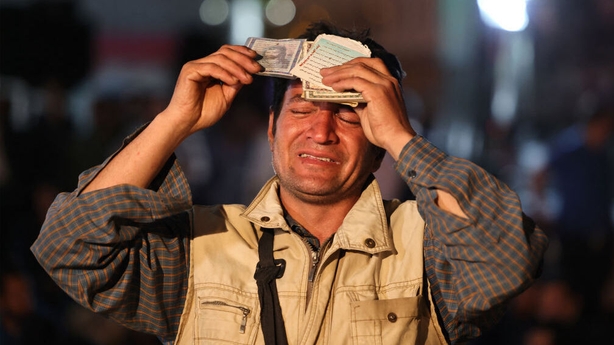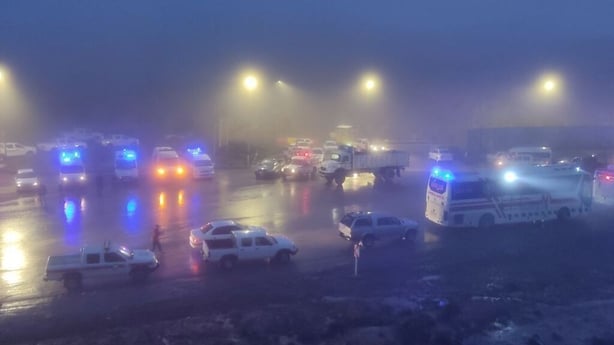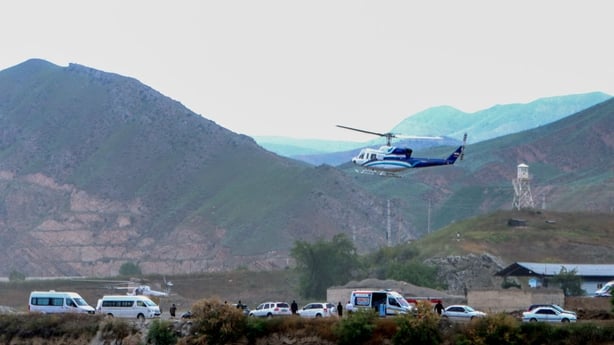Fear and worry have weighed on Iran as the Islamic republic await news on the fate of the country's president Ebrahim Raisi after his helicopter went missing in a foggy mountain area.
Thousands of Muslim faithful prayed for his safe return in mosques nationwide - including amid the minarets of 63-year-old Raisi's hometown, the shrine city of Mashhad.
Fears have grown for the 63-year-old ultraconservative after contact was lost with the aircraft carrying him as well as Iran's Foreign Minister Hossein Amir-Abdollahian and others in East Azerbaijan province, reports said.
Iran's supreme leader Ayatollah Ali Khamenei urged Iranians to "not worry" about the leadership of the Islamic republic, saying "there will be no disruption in the country's work".
"We hope that Almighty God will bring our dear president and his companions back in full health into the arms of the nation," he said in a nationally televised address as Muslim faithful prayed for Raisi's safe return.
Expressions of concern and offers to help came from abroad, including Iraq, Kuwait, Qatar, Saudi Arabia, Syria and Turkey, as well as from the European Union which activated its rapid response mapping service to aid in the search effort.

Earlier, an Iranian official said the lives of Mr Raisi and Iranian Foreign Minister Hossein Amirabdollahian were "at risk following the helicopter crash".
"We are still hopeful but information coming from the crash site is very concerning," the official told Reuters, speaking on condition of anonymity.
State TV quoted an official as saying that at least one passenger and one crew member had been in contact with rescuers.It also said the helicopter had been found, though Iran's Red Crescent denied this report.
Iranian Supreme Leader Ayatollah Ali Khamenei, who holds ultimate power with a final say on foreign policy and Iran's nuclear programme, sought to reassure Iranians, saying there would be no disruption to state affairs.
The bad weather is complicating rescue efforts, the state news agency IRNA reported. The chief of staff of Iran's army ordered all the resources of the army and the elite Revolutionary Guard to be put to use in the search and rescue operations.
Rescue operation under way in Iran
"It is dark and it has started raining, but the search continues. Rescue teams have reached the area ... however, the rain has created mud, making the search difficult," a local reporter told state TV.
State TV stopped all its regular programming to show prayers being held for Raisi across the country and, in a corner of the screen, live coverage of rescue teams deployed on foot in the mountainous area in heavy fog.
The rescue teams were expected to reach the probable site of the crash later this evening.
Neighbouring countries expressed concern and offered assistance in any rescue. The White House said US President Joe Biden had been briefed on reports about the crash.
The European commissioner for crisis management, Janez Lenarcic, said the commission had activated its satellite mapping service to aid search efforts, following a request for assistance from Iran.

The Copernicus Emergency Management Service provides mapping products based on satellite imagery.
A spokesperson for UN Secretary General Antonio Guterres said in a statement that he was following reports of the incident.
"He hopes for the safety of the president and his entourage," the statement added.
The incident happened in the mountainous forest area of Dizmar near the town of Varzaghan, according to the official IRNA news agency.
Mr Raisi, 63, was visiting the province today where he inaugurated a dam project together with his Azeri counterpart, Ilham Aliev, on the border between the two countries.
His convoy included three helicopters, and the other two had "reached their destination safely," according to Tasnim news agency.

IRNA said the Iranian foreign minister and local officials were travelling in the same helicopter as Mr Raisi.
The reformist Shargh daily also reported that "the helicopter carrying the president crashed" while two other helicopters landed safely.
Later, Iran’s interior minister Ahmad Vahidi said one of the helicopters "made a hard landing due to bad weather conditions".
He added that it was "difficult to establish communication" with the aircraft.
Years of crisis and conflict
Mr Raisi has been president of the Islamic Republic since June 2021, succeeding the moderate Hassan Rouhani, for a term during which Iran has faced crisis and conflict.
He took the reins of a country in the grip of a deep social crisis and an economy strained by US sanctions against Tehran over its contested nuclear programme.
Iran saw a wave of mass protests triggered by the death in custody of Iranian-Kurd Mahsa Amini in September 2022.
In March 2023, regional rivals Iran and Saudi Arabia signed a surprise deal that restored diplomatic relations.
The war in Gaza that began on 7 October sent regional tensions soaring again and a series of tit-for-tat escalations led to Tehran launching hundreds of missiles and rockets directly at Israel from Iran in April 2024.
Mr Raiasi, born in 1960 in northeast Iran's holy city of Mashhad, rose early to high office.
Aged just 20, in the wake of the 1979 Islamic revolution that toppled the US-backed monarchy, he was named prosecutor-general of Karaj next to Tehran.
He served as Tehran's prosecutor-general from 1989 to 1994, deputy chief of the judicial authority for a decade from 2004, and then national prosecutor-general in 2014.
His black turban signifies direct descent from Islam's Prophet Mohammed, and he holds the religious title of "hojatoleslam" - literally "proof of Islam" - one rank below that of ayatollah in the Shiite clerical hierarchy.

